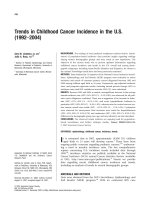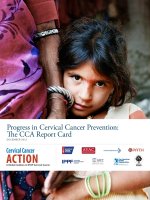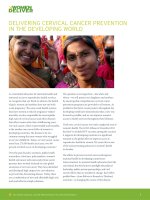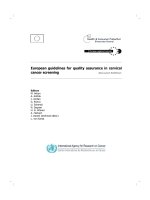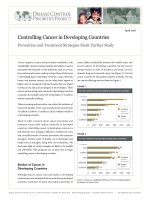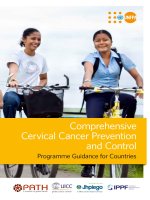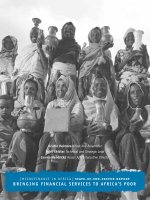Progress in Cervical Cancer Prevention: The CCA Report Card pot
Bạn đang xem bản rút gọn của tài liệu. Xem và tải ngay bản đầy đủ của tài liệu tại đây (3.05 MB, 28 trang )
Progress in CerviCal CanCer Prevention: tHe CCa rePort CarD
1
Progress in Cervical Cancer Prevention:
e CCA Report Card
DECEMBER 2012
Cover Photo: John-Michael Maas/Darby Communications
Progress in CerviCal CanCer Prevention: tHe CCa rePort CarD
2
A New Era for Cervical Cancer Prevention
FOREWORD
W
e live in an extraordinary time, one in which our
human need to generate knowledge, implement
creative solutions and follow through on heartfelt
commitments has resulted in a phenomenal opportunity to
virtually eliminate one of the greatest causes of suering
and loss for families and communities around the world.
Low-cost, eective solutions are required for the
prevention and treatment of cervical cancer in less
developed countries where the disease is the primary cause
of cancer-related deaths in women, and where annual
cervical cancer death rates are much higher than in more
developed countries. Such solutions should be underpinned
by education and advocacy initiatives to raise awareness
of the disease and its impact on women, their immediate
families and their countries.
Over the past decade, dedicated scientists, researchers,
clinicians, frontline health workers, community leaders and
advocates have worked tirelessly to bring the scourge of
cervical cancer to the world’s attention and to develop and
apply the necessary knowledge and technologies to prevent
cervical cancer in developing countries. From Mumbai to
Mexico City, Kampala to Kathmandu, innovative programs
have demonstrated how to successfully deliver eective
cervical cancer prevention and treatment to the women and
girls who need them most.
As this report highlights, countries are taking bold steps
to improve cervical cancer screening and treatment for adult
women and to successfully vaccinate girls against human
papillomavirus (HPV), the virus that causes cervical cancer.
Recently, the international community has begun to
take notice. Commitments by the GAVI Alliance to oer
HPV vaccines at subsidized rates to the poorest countries
worldwide represent the latest exciting ramp-up of
international leadership and support.
In order to save lives today, there must be an equal, if
not greater, commitment to expanding cervical cancer
prevention programs. Without support for a comprehensive
approach to preventing this disease—an approach that
includes cervical cancer screening and treatment and HPV
vaccination—countries with the highest burden of cervical
cancer are likely to be the last to oer these lifesaving
services at national scale.
With powerful solutions now within reach for all
countries, we have an obligation to change the course of
this disease. We strongly urge the international community
to recognize the need, opportunity and commitment
documented in this report and to act swiftly to provide
the leadership and resources necessary to encourage the
expansion of programs to save the mothers of our nations
and the families they nurture and preserve.
PROFESSOR HARALD ZUR HAUSEN
2008 NOBEL LAUREATE
PHYSIOLOGY OR MEDICINE
HER EXCELLENCY MADAME ZUMA
FIRST LADY OF SOUTH AFRICA
Progress in CerviCal CanCer Prevention: tHe CCa rePort CarD
3
Introduction
B
ased on the laboratory work of Professor zur Hausen
and his colleagues and critical epidemiological
studies of Dr. Nubia Muñoz and her colleagues, research
over the past decades has shown infection with certain
cancer-causing types of human papillomavirus (HPV) to be
the necessary, but not sucient, cause of cervical cancer.
is knowledge has proven fundamental to establishing
an unprecedented moment in cervical cancer prevention
where new locally appropriate screening and early treatment
technologies can dramatically reduce cervical cancer in
communities where the disease continues unabated. At the
same time, the advent of HPV vaccines, and their promise
of unprecedented prevention for the next generation, has
sparked a renewed interest in cervical cancer globally.
is conuence of knowledge, science and possibility
has triggered important changes in many high-income
countries and an astounding number of low-income
countries where, despite the near total lack of resources,
governments and civil society leaders have rallied to take
action.
Six years after HPV vaccines rst became available,
and thirteen years after the founding of the Alliance for
Cervical Cancer Prevention (ACCP)—the rst global
partnership aimed at reducing cervical cancer in high-
burden countries—Cervical Cancer Action oers this
snapshot of the international community’s collective eorts
to improve cervical cancer prevention, particularly in low-
and middle-income countries where the burden of disease
remains unacceptably high.
Successful national programs have a number of elements
in place that allow for a comprehensive strategy to reduce
both current and future incidence and mortality from
this disease. Endorsed by the WHO and other leading
institutions, an eective comprehensive approach to cervical
cancer prevention should:
•Educate women, providers and communities about cervical
cancer—its cause and prevention
•Prevent HPV infection, where possible, through
vaccination of adolescent girls
•Ensure women’s access to screening to detect pre-
cancerous changes and early treatment before invasive
cancer occurs
•Encourage the development of national plans to
strengthen coordination and mobilize adequate human
and nancial resources to sustain prevention eorts, and
•Strengthen vital health information systems to monitor
program impact.
“IN THE ABSENCE OF INTERNATIONAL SUPPORT,
DEVELOPING COUNTRIES ARE STRUGGLING
WITH THE HIGH COST OF INACTION ”
Progress in CerviCal CanCer Prevention: tHe CCa rePort CarD
4
is report documents eorts taken by countries,
communities and their international partners to ght
this disease, particularly in low- and middle-income
countries where prior eorts failed to deliver. ese early
steps have been hard won. In the absence of international
support, many developing countries are struggling with the
high cost of inaction and the challenge of garnering the
resources necessary for success. We hope this report will
help the international community better understand the
scale and commitment of the eort underway in low- and
middle-income countries and the importance of its own
engagement to ensure a better future for women, families
and communities.
Photo: PATH/Wendy Stone
Progress in CerviCal CanCer Prevention: tHe CCa rePort CarD
5
e Global Burden of Cervical Cancer
CHAPTER 1
G
lobal cervical cancer mortality highlights the in-
equities of our time—inequities in wealth, gender
and access to health services. Women worldwide are ex-
posed to HPV, yet it is primarily women in the developing
world who—over decades—have little or no access to early
screening and treatment and who die from the consequences
of this virus. Today, cervical cancer is the second most com-
mon cancer among women in the developing world, and
CURRENT CERVICAL CANCER MORTALITY RATE
ESTIMATED AGE-STANDARDIZED MORTALITY RATE PER 100,000, CERVIX UTERI.
1.1
17.6 AND ABOVE
10.8 –17.6
5.8–10.8
2.7–5.8
0–2.7
• FerlayJ,ShinHR,BrayF,FormanD,MathersC,ParkinDM.GLOBOCAN2008,CancerIncidenceandMortalityWorldwide:IARCCancerBaseNo.10.Lyon,France:
InternationalAgencyforResearchonCancer;2010.globocan.iarc.fr.AccessedOctober5,2010.
SOURCES
Photo: PATH/Nga Le
Progress in CerviCal CanCer Prevention: tHe CCa rePort CarD
6
the largest cancer killer among women in most developing
countries. Each year, over 500,000 women develop cervi-
cal cancer and about 275,000 women die from the disease.
1
e vast majority of these unnecessary deaths occur in de-
veloping countries, or in disadvantaged communities within
wealthy countries.
Over the past several decades, we have witnessed a steady
drop in cervical cancer incidence and mortality rates in
high-income countries. Eective early screening and treat-
ment technologies have driven these reductions, allowing
clinicians to detect and remove cervical anomalies before
invasive cancer develops. In many countries, these eorts
have been complemented by public education, clinician
training, improved cancer treatment and strong health
information systems designed to capture data and assess the
impact of programs and policies. Despite ongoing chal-
lenges in reaching marginalized communities, these eorts
have paid o. For example, between 1955 and 1992, cervi-
cal cancer mortality in the United States declined by nearly
70% and rates continue to drop by about 3% each year.
2
Similarly, in the United Kingdom, cervical cancer rates
were 70% lower in 2008 than they were 30 years earlier.
3
In low- and middle-income countries, similar success has
not yet been achieved. After decades of eort to implement
the strategies of high-income countries, less-developed
countries are still struggling to nd an eective response.
Meanwhile, the disease continues to grow, fanned by gains
in life expectancy and population growth. By 2030, cervical
cancer is expected to kill over 474,000 women per year and
over 95% of these deaths are expected to be in low- and
middle-income countries. In sub-Saharan Africa alone,
cervical cancer rates are expected to double.
4
“BY 2030, CERVICAL CANCER IS EXPECTED TO KILL
OVER 474,000 WOMEN PER YEAR—OVER 95% OF
THESE DEATHS ARE EXPECTED TO BE IN LOW-
AND MIDDLE-INCOME COUNTRIES.”
e loss of these women—mothers, daughters, sisters,
wives, partners, and friends—is almost entirely prevent-
able. e following chapters will describe eorts underway
to change the course of this disease in low- and middle-
income countries.
1. FerlayJ,ShinHR,BrayF,FormanD,MathersC,ParkinDM.GLOBOCAN
2008,CancerIncidenceandMortalityWorldwide:IARCCancerBaseNo.
10.Lyon,France:InternationalAgencyforResearchonCancer;2010.
globocan.iarc.fr.AccessedOctober5,2010.
2. DetailedGuide:Whatarethekeystatisticsaboutcervicalcancer?Ameri-
canCancerSocietywebsite.www.cancer.org/Cancer/CervicalCancer/
Detailedguide/cervical-cancer-key-statistics.RevisedDecember16,2010.
AccessedJanuary31,2011.
3. CervicalCancerUKMortalityStatistics.CancerResearchUKwebsite.
info.cancerresearchuk.org/cancerstats/types/cervix/mortality/.Accessed
November23,2010.
4. Projectionsofmortalityandburdenofdisease,2004-2030.WorldHealth
Organizationwebsite.www.who.int/healthinfo/global_burden_disease/
projections/en/index.html.AccessedNovember23,2010.
Progress in CerviCal CanCer Prevention: tHe CCa rePort CarD
7
CHAMPION PROFILE
ERICK ALVAREZ-RODAS, MD
DIRECTOR, NATIONAL CERVICAL CANCER
PREVENTION PROGRAM, GUATEMALA
Screening and Early Treatment
CHAPTER 2
O
ver the last decade, our knowledge, tools and
capacity to screen and treat cervical pre-cancer
have changed dramatically. e Papanicolaou test,
commonly called the Pap test or smear, has been the gold
standard for cervical cancer screening worldwide. is
strategy has been eectively employed in high-income
settings despite its sub-optimal performance in correctly
identifying women with pre-cancerous lesions. is
challenge has been mediated by frequent testing, strong
systems to recall women with abnormal results and high
rates of follow-up among women who need to return to a
clinic for treatment.
In low- and middle-income settings, however, the Pap has
performed even less ideally—as the conuence of poor test
performance, limited recall systems, cost and challenges
preventing many women from traveling repeatedly to
clinics have crippled screening systems for decades. Today,
new alternatives to the Pap test represent a breakthrough
in our ability to deliver eective cervical cancer prevention
in all resource settings. Over the next decades, new and
eective screening and early treatment methods will be
the primary drivers of reduced suering and death from
cervical cancer since HPV vaccination will not show an
impact on incidence and mortality for years to come.
An inspiration to all who have worked
with him, Dr. Erick Alvarez-Rodas has
committed his career to improving the
health of women in his native Guatemala.
An obstetrician/gynecologic oncologist,
surgeon and committed advocate, Dr.
Alvarez-Rodas has worked tirelessly to improve the quality and
scope of Guatemala’s cervical cancer prevention program. Dr.
Alvarez-Rodas is the Medical Director of Guatemala City’s Center
for Cancer Prevention and Care and Director of Guatemala’s
national cervical cancer prevention program within the Ministry
of Health and Social Services. At the helm of Guatemala’s cervical
cancer prevention effort, Dr. Alvarez has sought untraditional
ways to reach women in isolated indigenous communities where
cervical cancer rates have been extraordinarily high. He has
been credited with making cervical cancer a national priority,
introducing visual inspection with acetic acid (VIA) and expanding
cryotherapy, and improving training for the next generation
of clinicians through the development of innovative education
programs and the accreditation of colposcopists at all levels of the
Guatemalan national health system.
Photo: PATH/Wendy Stone
“TODAY, OVER FIFTY LOW-INCOME COUNTRIES
HAVE INTRODUCED VIA ON A NATIONAL OR
PILOT BASIS.”
Progress in CerviCal CanCer Prevention: tHe CCa rePort CarD
8
As shown in gures 2.1 and 2.2, important new screening
methods and approaches are becoming available in
high-, middle- and low-income countries. Pap testing
is likely to be complemented or even replaced as two
new methods become available: one that responds to the
technical and logistical challenges mentioned above and
another—a highly sensitive and objective test that detects
HPV, enabling a shorter turnaround time to identify and
treat pre-cancerous lesions. Both have the potential to
signicantly improve the reach and outcomes of cervical
cancer prevention programs.
VIA AND THE “SCREEN AND TREAT”
APPROACH
International research, pilot programs and innovative
public-private partnerships in low-resource settings have
established a solid evidence base and new array of tools
that are shifting the paradigm of cervical cancer screening.
Largely driven by the research eorts of the ACCP, new
approaches were developed to counter program challenges
often encountered in developing countries, while at the
same time delivering high-quality care for women. e
ACCP and other partners proved that visually inspecting
the cervix after applying a staining solution of acetic acid
(VIA) or Lugol’s iodine (VILI) was as eective or more
eective at identifying women with pre-cancerous lesions
as the Pap test. is technologically simple approach can be
performed by mid-level health personnel. Cryotherapy can
be oered for pre-cancer treatment the same day, or very
soon after screening and without an additional diagnostic
conrmation step. is approach has proven its safety,
eectiveness and appropriateness in the most dicult to
reach communities, especially as it signicantly reduces the
burden of repeat visits for women who live far from health
services. Compressing cervical cancer prevention into as few
visits as possible increases program impact by reducing the
likelihood that women may be lost to follow-up.
Several international NGOs have been instrumental
in establishing pilot programs and providing technical
assistance to governments, which are increasingly including
VIA and the Screen and Treat approach in their national
norms and programs. Today, over fty low-income countries
have introduced VIA on a national or pilot basis. ailand is
the rst nation to use VIA throughout the country. Twenty-
four other countries have included VIA in their national
norms and have introduced the method in areas previously
lacking screening services. Twenty-eight countries have
ongoing VIA pilot programs. In countries like Vietnam,
although VIA is currently not included in the national
norms, it is available through NGO partners in many areas
of the country. Additionally, in many of the countries
highlighted in gure 2.1, the rst-time introduction of
screening methods has been complemented by crucial eorts
to increase community awareness about cervical cancer and
to improve follow-up and referral mechanisms for women in
need of more advanced cancer care. Drivers of change, visual
inspection strategies oer a viable solution to communities
where previously there were no options.
NATIONAL PROGRAMS
Bangladesh
Bolivia
Cambodia
China
Colombia
El Salvador
Guatemala
Guyana
Indonesia
Kenya
Malawi
Morocco
Mozambique
Nicaragua
Panama
Paraguay
Peru
Philippines
Rwanda
Suriname
Tanzania
Thailand
Uganda
Vietnam
PILOT PROGRAMS
Angola
Bangladesh
Botswana
Burkina Faso
Cameroon
Côte d’Ivoire
Ethiopia
Ghana
Grenada
Guinea
Haiti
Honduras
India
Lesotho
Madagascar
Mali
Myanmar
Namibia
Nepal
Nigeria
Republic of Congo
Rwanda
South Africa
St. Lucia
Sudan (North)
Turkey
Vanuatu
Zambia
INTRODUCTION OF VISUAL INSPECTION
(
VIA
) FOR CERVICAL CANCER SCREENING
STATUS: OCTOBER 2012
• CervicalCancerActioncommunicationwithPATH(September2012),Jhpiego(September2012),theAustralianCervicalCancerFoundation(November2010),Groundsfor
Health(October2010),BasicHealthInternational(October2010)andthePanAmericanHealthOrganization(September2012).
SOURCES
2.1
NATIONAL PROGRAMS
:
VISUAL INSPECTION IN THE NATIONAL SCREENING NORMS
AND AVAILABLE ON A LIMITED OR UNIVERSAL BASIS THROUGH THE PUBLIC SECTOR
PILOT PROGRAMS
:
VISUAL INSPECTION AVAILABLE THROUGH PILOT OR DEMONSTRATION
PROJECTS ORGANIZED BY THE MINISTRY OF HEALTH OR NGO PARTNERS
NO VIA PROGRAM
Theinformationrepresentedherehasbeen
collectedthroughinterviewswithindividuals
andorganizationsinvolvedwiththecountries
representedandhasnotbeenveriedwith
individualMinistriesofHealth.Anyoversightsor
inaccuraciesareunintentional.
Progress in CerviCal CanCer Prevention: tHe CCa rePort CarD
9
Progress in CerviCal CanCer Prevention: tHe CCa rePort CarD
10
HPV DNA TESTING
HPV DNA testing is a new molecular approach to
screening that detects the presence of cancer-causing
types of HPV. is testing approach is most appropriate
for women over 30 years of age, when persistent infection
with these types of HPV indicate an important risk factor
for cervical pre-cancer and cancer. Increasingly available
in high-income settings, current HPV DNA testing
platforms are suited for areas with developed laboratory
infrastructure. Much like a Pap test, a cervical sample is
taken during a clinical exam (or by self-sampling), then
transported to a laboratory for processing. For those who
can aord to introduce HPV DNA testing, this powerful
screening method has proven to be signicantly more
capable of identifying positive cases than either the Pap
or visual inspection methods. is allows for earlier and
more eective treatment, resulting in reductions in cervical
cancer rates and mortality.
1
It also introduces the possibility
to reduce the number of screenings needed in a woman’s
lifetime.
As indicated in gure 2.2, the United States and Mexico
have included HPV DNA testing in their national norms
and have made the test broadly available. e United States
was the rst country to introduce HPV DNA testing as a
primary screening protocol, in conjunction with the Pap
test. Italy and Spain also have included HPV DNA testing
in their national norms and have made the test available
in a pilot capacity in target communities and provinces. In
addition, over a dozen European countries are currently
investigating the cost and operational impact of a full-scale
switch to HPV DNA testing in their national screening
Photo: PATH/Mike Wang
“OVER THE NEXT DECADE, NEW AND
EFFECTIVE SCREENING AND EARLY
TREATMENT METHODS WILL BE THE PRIMARY
DRIVERS OF REDUCED SUFFERING AND DEATH
FROM CERVICAL CANCER.”
SPOTLIGHT
CareHPV AND SELF-SAMPLING: BREAKING PARADIGMS
In some low-resource settings, long waits at clinics or patient
embarrassment seeing male providers can reduce a woman’s
comfort and adherence with screening regimens. Current eld
studies examining the introduction of the careHPV test are
researching the effectiveness of self-sampling coupled with
HPV DNA testing. Studies comparing specimens collected by
physicians to those collected by women themselves are nding
only a slight drop in test performance for the vaginal self-samples.
Assuming the response from women and providers continues
to be positive, allowing women to take their own samples might
prove an effective and efcient way forward, encouraging more
women to get screened and reducing the burden of cervical
screening on already pressured health systems.
INTRODUCTION OF HPV DNA TESTING FOR CERVICAL CANCER SCREENING
STATUS: OCTOBER 2012
NATIONAL PROGRAMS
Mexico
United States
PILOT PROGRAMS
China
Colombia
El Salvador
Germany
India
Italy
Nicaragua
Paraguay
Peru
Republic of Georgia
Photo:PATH/MikeWang
“MEXICO WAS THE FIRST COUNTRY IN LATIN AMERICA
TO INTRODUCE HPV DNA TESTING INTO ITS NATIONAL
SCREENING PROGRAM.”
2.2
NATIONAL PROGRAMS
:
HPV DNA TESTING IN THE NATIONAL SCREENING NORMS
AND AVAILABLE ON A LIMITED OR UNIVERSAL BASIS THROUGH THE PUBLIC SECTOR
PILOT PROGRAMS
:
HPV DNA TESTING AVAILABLE THROUGH PILOT OR DEMONSTRATION
PROJECTS ORGANIZED BY THE MINISTRY OF HEALTH OR NGO PARTNERS
NO HPV DNA TESTING PROGRAM
• CervicalCancerActioncommunicationwithPATH
(September2012),thePanAmericanHealthOrganization
(September2012)andQIAGEN(September2012).
SOURCES
Theinformationrepresentedherehasbeen
collectedthroughinterviewswithindividuals
andorganizationsinvolvedwiththecountries
representedandhasnotbeenveriedwith
individualMinistriesofHealth.Anyoversightsor
inaccuraciesareunintentional.
Rwanda
Spain
Uganda
Progress in CerviCal CanCer Prevention: tHe CCa rePort CarD
11
Progress in CerviCal CanCer Prevention: tHe CCa rePort CarD
12
80
70
AGE-STANDARDIZED MORTALITY RATE
SCREENING RATE %
60
50
40
30
20
10
4 8 12 16 20 24 28 32
36
programs. It is anticipated that several will begin using the
method as a primary screening test in the coming years.
In low- and middle-income countries, the uptake of
HPV DNA testing has been slower and more challenging.
e cost of current HPV tests, along with the necessary
infrastructural costs of improving treatment and reporting
systems, has been daunting. Knowing that its investments
will ultimately translate into nancial savings and also will
reduce suering, Mexico became the rst country in Latin
America to introduce HPV DNA testing into its national
screening program.
e interest and enthusiasm for HPV DNA testing
among other low- and middle-income governments is
considerable. However, many are patiently anticipating
a new HPV DNA testing platform that is expected to
GROSS NATIONAL INCOME PER CAPITA
$996 AND BELOW
$12,196 AND ABOVE
$3,946 –$12,195
$996–$3,945
WEALTH, SCREENING COVERAGE, AND MORTALITY
A SAMPLE OF COUNTRIES REPORTING ON 3-YEAR SCREENING RATES
2.3
make this technology viable even in low-resource settings.
Based on the laboratory HPV DNA test, but adapted for
use in areas with minimal laboratory infrastructure, the
careHPV
TM
test was developed through a public-private
partnership between PATH and one of the primary
manufacturers of HPV DNA tests. CareHPV
TM
will
potentially allow for same-day testing and treatment in
low-resource settings. Anticipated to become available
soon, there is a growing need to provide guidance and
technical support to countries interested in introducing this
technology at a national level.
High-incomecountrieshavethehighest
screeningratesandlowestcervicalcancer
mortality,whilelow-andmiddle-income
countriescontinuetohavesignicantlylower
screeningratesandhighmortality.
• InformationCentreonHPVandCervicalCancer.Geneva:WorldHealthOrganization/InstitutCatalàd’Oncologia;2007.
apps.who.int/hpvcentre/statistics/dynamic/ico/SummaryReportsSelect.cfm.AccessedOctober16,2010.
• GNIpercapita,PPP(currentinternational$).TheWorldBankGroupwebsite.data.worldbank.org/indicator/NY.GNP.PCAP.PP.CD.
AccessedDecember4,2010.
• FerlayJ,ShinHR,BrayF,FormanD,MathersC,ParkinDM.GLOBOCAN2008,CancerIncidenceandMortalityWorldwide:IARCCancerBaseNo.10.Lyon,France:Interna-
tionalAgencyforResearchonCancer;2010.globocan.iarc.fr.AccessedOctober5,2010.
SOURCES
40
Progress in CerviCal CanCer Prevention: tHe CCa rePort CarD
13
AVAILABILITY OF TREATMENT
Regardless of the screening method, no cervical cancer
prevention program can be eective without oering
treatment for women with pre-cancer, and referral and
higher-level treatment for women with cancer. Even today,
access to early treatment remains the Achilles’ heel of
cervical cancer prevention programs. Fortunately, some
low- and middle-income countries are beginning to seek
international support to improve their early treatment
systems. Over the past several years, governments and non-
governmental partners have looked to improve cryotherapy
equipment, train providers in cryotherapy and help put
sustainable systems in place.
e treatment of cancer within developing country health
systems remains tragically weak. Few middle-income
countries and even fewer low-income countries have the
resources to treat a woman with invasive cervical cancer or
help manage the horrible pain of cancer suerers.
A much stronger investment in screening and treatment
systems is needed urgently. At present, no international
donor provides nancial resources for the scaling up of
screening and treatment programs in the lowest-income
countries. e challenge of establishing the infrastructure,
training the providers, and securing the necessary
equipment to provide services at scale continues to plague
governments that are all too familiar with the ravages of
this disease.
1. SankaranarayananR,NeneBM,ShastriSS,etal.HPVScreeningfor
CervicalCancerinRuralIndia.NEnglJMed.Apr22009;360(14):1385-
1394.
SPOTLIGHT
DATA SUPPORT THE USE OF CRYOTHERAPY
Ensuring that women with abnormal screening outcomes have access to safe, effective and affordable early treatment is crucial to sav-
ing lives and having an impact on cervical cancer rates. The lack of trained physicians and poor access to surgical facilities have been
key treatment barriers in low- and middle-income countries. A method called cryotherapy, which uses a compressed gas to freeze and
destroy abnormal cervical cells, is a proven alternative. This outpatient procedure does not rely on electricity or sophisticated medical
infrastructure and can be safely performed by trained non-physician providers.
Research in Asia and Africa has shown that cryotherapy is a feasible and effective way to prevent and treat cervical cancer in low-
resource settings, and can be combined with VIA or VILI to “Screen and Treat” women. To successfully include the method in their
health systems, many countries will need to resolve logistical issues, such as securing a reliable local gas supply. They will also need to
revise practice guidelines to shift treatment tasks to non-physician providers and train providers according to standardized guidelines
to ensure quality care. The WHO and its partners are currently developing new guidance on technical specications and clinical recom-
mendations.
SOURCES
• JHPIEGO.GlossaryofCervicalCancerTerms.TheReadingRoomwebsite.www.reproline.jhu.edu/english/6read/6gloss/glosscc.htm.
AccessedNovember29,2010.
• JacobM,BroekhuizenFF,CastroW,SellorsJ.Experienceusingcryotherapyfortreatmentofcervicalprecancerouslesionsinlow-resourcesettings. Int J Gynaecol Obstet.
May2005;89(suppl2):S13-20.
Progress in CerviCal CanCer Prevention: tHe CCa rePort CarD
14
Preventing HPV Infection
CHAPTER 3
S
creening and early treatment are used to identify and
treat pre-cancer after infection has already occurred
and persisted, but newly developed HPV vaccines can pre-
vent infection with the two most common cancer-causing
types of HPV. In order for this vaccine to be most eective,
a girl should be vaccinated prior to HPV infection, which
often occurs soon after sexual debut.
Since 2006, HPV vaccine has become available in many
countries either through government vaccination programs
or to individuals who can aord to pay through the private
sector. Eectively targeting the two most common cancer-
causing types of HPV (types 16 and 18), the HPV vaccine
has the potential (if successfully introduced) to dramatically
reduce the future burden of cervical cancer. Because cervi-
cal cancer takes years to develop, reductions in vaccine-
preventable disease will not become apparent for years to
come. In Australia, however, a recent reduction of genital
warts among women provides early indication that the
quadrivalent vaccine (which also protects against HPV 6
and 11, the causes of genital warts) is working against HPV
infection.
1
Post-introduction monitoring has demonstrated
that HPV vaccines have an excellent safety prole.
2
Australia, Canada, New Zealand, the United Kingdom
and the United States were among the rst countries to
introduce HPV vaccine in 2007 and early 2008. Acknowl-
edging the potential of the vaccine to alleviate the public
health and nancial burden of national cancer prevention
and treatment programs, many other high-income countries
quickly followed suit. In some countries, including Aus-
tralia, Canada, Denmark, the Netherlands, New Zealand
and the United Kingdom, early vaccination eorts included
catch-up campaigns to reach the maximum number of girls
and young women who could possibly benet from HPV
vaccination. Even though they have robust screening and
early treatment programs in place, and relatively low cervi-
cal cancer mortality, the number of high-income countries
establishing HPV vaccine programs continues to grow. By
vaccinating, these countries hope to further reduce mortal-
ity and minimize morbidity and costs related to treatment.
As of September 2012, there were 51 national public sec-
tor HPV immunization programs and 26 pilot programs
globally.
Progress in CerviCal CanCer Prevention: tHe CCa rePort CarD
15
e greatest public health impact of HPV vaccination
will be in low- and middle-income countries where large
portions of the population live with limited or no access to
early screening and pre-cancer treatment, and where cancer
treatment and palliative care continue to fall short of need.
Among middle-income countries, Mexico was one of the
earliest to introduce a public sector HPV immunization
program. In 2008, Mexico initiated a pilot program
targeting girls in the 125 municipalities (representing
10% of Mexican municipalities) with the lowest human
development indices. Also in 2008, Panama became the rst
middle-income country to provide universal access to HPV
vaccination. Peru plans to follow suit in 2011. e availability
of HPV vaccine through the Pan American Health
Organization’s EPI Revolving Fund gives participating
governments in Latin America and the Caribbean access
to the HPV vaccine at signicantly reduced prices—the
high-income country vaccine prices being vastly out of reach
for low- and middle-income countries. is price drop is
expected to increase the speed with which governments in the
Americas can introduce HPV vaccine and consequently foster
additional future price decreases.
Over half of the global cervical cancer burden exists in countries
that are eligible for GAVI support, and the organization is
responding by offering HPV vaccine for the rst time in 2013. With
the goal of vaccinating tens of millions of girls by 2025, GAVI is
working closely with governments and civil society to introduce
HPV vaccine in countries throughout the developing world.
There are two ways that countries may apply for HPV vaccine
support through GAVI: Countries that meet GAVI’s eligibility
threshold (low-income and DTP3 coverage of 70%) and have
demonstrated the ability to reach adolescent girls with HPV
or other multi-dose vaccines, can apply for GAVI-supported
national introduction. Eligible countries that do not yet have
enough experience reaching these girls may apply for vaccine and
support to conduct a smaller-scale, demonstration project. The
demonstration program provides the opportunity for countries to
“learn by doing” and gain the experience necessary to apply for
national rollout of vaccine.
GAVI has been working with vaccine manufacturers on strategies
to reduce the price of HPV vaccine, so that it is affordable and
sustainable for poorer countries. In 2011, one manufacturer made
an indicative price offer to GAVI countries of US$5 per dose. GAVI
and partners are working towards a further price reduction within
the tender process. GAVI’s co-nancing policy means that low-
income countries carrying out national introductions will pay only
20 cents per dose as co-payment, a fraction of the actual vaccine
price.
GAVI’s decision to tackle the burden of cervical cancer in
countries with the most need will accelerate the reach of HPV
vaccination, and help to protect future generations of women
against a preventable cancer.
SPOTLIGHT
THE GAVI ALLIANCE STEPS UP TO MAKE HPV
VACCINE AVAILABLE IN LOW-INCOME COUNTRIES
NATIONAL PROGRAMS
American Samoa
Argentina
Australia
Austria
Belgium
Bermuda
Bhutan
Brunei
Canada
Cayman Islands
Colombia
Cook Islands
Denmark
Fiji
France
French Polynesia
Germany
Greece
Guam
Ireland
Italy
Japan
Latvia
Lesotho
Luxembourg
Malaysia
Marshall Islands
Mexico
Micronesia
Netherlands
New Caledonia
New Zealand
Niue
Norway
Northern Mariana
Palau
PILOT PROGRAMS
Bolivia
Brazil
Cambodia
Cameroon
Costa Rica
Ghana
Guyana
Haiti
Honduras
India
Kenya
Kiribati
Mali
Moldova
Mongolia
Morocco
Nepal
Nigeria
Papua New Guinea
Philippines
Republic of Georgia
Tanzania
Thailand
Uganda
Uzbekistan
Vietnam
INTRODUCTION OF HPV VACCINE
STATUS: OCTOBER 2012
3.1
NATIONAL PROGRAMS
:
HPV VACCINE IN NATIONAL NORMS AND AVAILABLE
ON A LIMITED OR UNIVERSAL BASIS THROUGH THE PUBLIC SECTOR
PILOT PROGRAMS
:
HPV VACCINE AVAILABLE THROUGH PILOT OR DEMONSTRATION
PROJECTS ORGANIZED BY THE MINISTRY OF HEALTH OR NGO PARTNERS
NO HPV VACCINE PROGRAM
Theinformationrepresentedherehasbeen
collectedthroughinterviewswithindividuals
andorganizationsinvolvedwiththecountries
representedandhasnotbeenveriedwith
individualMinistriesofHealth.Anyoversightsor
inaccuraciesareunintentional.
Panama
Peru
Portugal
Republic of Macedonia
Romania
Rwanda
San Marino
Singapore
Slovenia
Spain
Sweden
Switzerland
Suriname
United Kingdom
United States
Progress in CerviCal CanCer Prevention: tHe CCa rePort CarD
16
“LESSONS NOW EMERGING FROM THESE EARLY
PROJECTS ARE ESTABLISHING A SOLID EVIDENCE
BASE FOR THE WIDESPREAD INTRODUCTION
OF HPV VACCINE, EVEN IN THE MOST
CHALLENGING SETTINGS.”
Photo: PATH/Amynah Janmohamed
Progress in CerviCal CanCer Prevention: tHe CCa rePort CarD
17
COUNTRY PROFILE
FROM EVIDENCE TO IMPACT: HPV VACCINES AND PERU
Introducing any new service can be challenging for health
systems. This is especially true in communities where there’s a
lack of awareness that cervical cancer is preventable. The HPV
Vaccines: Evidence for Impact project—a collaboration between
PATH and the Peruvian Ministry of Health (MINSA)—set out to
generate the information that policymakers and communities
needed to make informed choices about the most efcient and
cost-effective strategies for delivering HPV vaccines in their
communities. For example, does it make more sense to vaccinate
at schools—where health teams can reach many girls in one
location—or to ask parents to bring their daughters to a clinic to
receive the three vaccine doses?
Over the past six years, ministries of health, civil society and
international institutions have focused on creating a foundation
for future HPV vaccine introduction in low- and middle-income
settings. For example, beginning in 2006, PATH, an international
NGO, established demonstration projects in India, Peru, Uganda
and Vietnam to assess the acceptability of HPV vaccination and
compare vaccine delivery strategies. Encouraged by early posi-
tive results, other developing countries also have organized pilot
projects—and more will begin to with help from GAVI.
From 2008 to 2009, more than 10,000 Peruvian girls received
HPV vaccines through the project, implemented by the National
Expanded Program for Immunization (ESNI) of the Ministry of
Health. Studies evaluating the pilot provided critical lessons
on how to reach every girl with HPV vaccine, whether she is
in an urban, rural or peri-urban area, and on how to talk to
communities about cervical cancer, HPV vaccination and adult
screening and treatment. The success of this collaborative effort
provided the government of Peru with the evidence it needed
to begin national immunization in 2011—a victory for cervical
cancer prevention in one of the Latin American countries hardest
hit by this disease.
For a summary of lessons learned in all four PATH projects, visit:
www.rho.org/HPV-practical-experience.htm.
Progress in CerviCal CanCer Prevention: tHe CCa rePort CarD
18
ese programs continue to dispel concerns that HPV
vaccine might prove unacceptable to families, or too dif-
cult to deliver in lower-resource settings. In fact, the
opposite seems to be true: ere has been an extraordi-
nary demand for vaccine among girls, parents, physicians
and ministries of health. With good planning and strong
communication and community mobilization eorts, vac-
cine coverage rates have been high—usually 80% or more.
Furthermore, eorts to introduce HPV vaccine show a
secondary benet of increasing public awareness about cer-
vical cancer in general and increasing demand for screening
among adult women.
e World Health Organization (WHO) and other
health institutions now advocate for the introduction of
HPV vaccine as part of a national cervical cancer control
strategy in countries where it is feasible and cost-eective,
and where the vaccine can be delivered to adolescent girls
eectively.
1. FairleyCK,HockingJS,GurrinLC,ChenMY,DonovanB,BradshawCS.
Rapiddeclineinpresentationsofgenitalwartsaftertheimplementation
ofanationalquadrivalenthumanpapillomavirusvaccinationprogramme
foryoungwomen.Sex Transm Infect.Dec2009;85(7):499-502.
2. CervicalCancerAction.Issue Brief: HPV Vaccine Safety.2010;1-5.cervical-
canceraction.org/pubs/CCA_HPV_vaccine_safety.pdf.AccessedJanuary
19,2011.
Progress in CerviCal CanCer Prevention: tHe CCa rePort CarD
19
• CervicalCancerActioncommunicationwiththeWHO(October2010),AxiosInternational(October2010),PATH(October2010),theAustralianCervicalCancerFoundation
(November2010)anddirectcommunicationwithMinistriesofHealthinAustralia,NewZealand,Denmark,Canada,theUK,Sweden,Switzerland,Germany,theNetherlands,
Slovenia,andtheUnitedStatesofAmerica(November2010).
• Vaccinepreventablediseasesmonitoringsystem.Geneva:WorldHealthOrganization;2010.
apps.who.int/immunization_monitoring/en/globalsummary/ScheduleSelect.cfm.AccessedOctober19,2010.
• WorldHealthOrganization.CountriesUsingHPVVaccinesin2010PowerPointslide.
In: CCA Webinars, HPV vaccination in developing countries October 21, 2010.
• EuropeanCervicalCancerAssociation. Vaccination Across Europe.Brussels;2009:1-16.
• HumanPapillomavirus.ImmuniseAustraliaProgramwebsite.
www.immunise.health.gov.au/internet/immunise/publishing.nsf/Content/immunise-hpv.AccessedDecember15,2010.
• KingLA,Lévy-BruhlD,O’FlanaganD,etal.IntroductionofHumanPapillomavirus(HPV)VaccinationintoNationalImmunisationSchedulesinEurope:ResultsoftheVenice
2007Survey. Euro Surveill.2008;13(33).www.eurosurveillance.org/ViewArticle.aspx?ArticleId=18954.
AccessedDecember15,2010.
• SimoensC,SabbeM,VanDammeP,BeutelsP,ArbynM.IntroductionofHumanPapillomavirus(HPV)VaccinationinBelgium,2007-2008.Euro Surveill. 2009;14(46):1-4.www.
eurosurveillance.org/ViewArticle.aspx?ArticleId=19407.AccessedDecember15,2010.
• ArbynM,SimoensC,VanDammeP,etal.IntroductionofHumanPapillomavirusVaccinationinBelgium,LuxembourgandtheNetherlands.Gynecol Obstet Invest.
2010;70(4):224-232.content.karger.com/produktedb/produkte.asp?doi=314010.AccessedDecember15,2010.
• TheFACTSontheSafetyandEffectivenessofHPVVaccine.PublicHealthAgencyofCanadawebsite.
www.phac-aspc.gc.ca/std-mts/hpv-vph/fact-faits-vacc-eng.php.AccessedDecember15,2010.
• TwoMoreEuropeanCountriesRecommendFreeHumanPapillomavirusVaccinationforPre-adolescentGirlstoPreventCervicalCancer.MedicalNewsTodaywebsite.www.
medicalnewstoday.com/articles/85624.php.AccessedDecember15,2010.
• 8000takeHPVvaccine.TheFijiTimesOnlinewebsite.www.jitimes.com/story.aspx?id=131093.AccessedDecember15,2010.
• OpeningCeremonyfortheHumanPapillomavirus(HPV)VaccineSymposium.OfceofthePresident:MarshallIslandswebsite.
www.rmigovernment.org/news_detail.jsp?docid=244.AccessedDecember15,2010.
• KosraeHPVCampaign.CentersforDiseaseControlandPreventionwebsite.www.cdc.gov/cancer/ncccp/kosrae.htm.AccessedDecember15,2010.
• NewZealandPrimeMinisterAnnouncesFundingforNewHPVVaccineProgram.MedicalNewsTodaywebsite.
www.medicalnewstoday.com/articles/106370.php.AccessedDecember15,2010.
• IttakesThree:Hukipuipuimaekenesahehalafanau.MinistryofHealthNewZealand:CervicalCancerVaccinewebsite.
www.cervicalcancervaccine.govt.nz/webfm_send/9.AccessedDecember15,2010.
• U.S.toFundHPVVaccinationCampaigninMicronesiaRegion.MedicalNewsTodaywebsite.www.medicalnewstoday.com/articles/134875.php.
AccessedDecember15,2010.
• HPVVaccines.CancerResearchUKwebsite.www.cancerhelp.org.uk/about-cancer/cancer-questions/cervical-cancer-vaccine.
AccessedDecember16,2010.
• TheHPVVaccination:WhatHaveWeLearned?MDAndersonCancerCenterwebsite.
www.mdanderson.org/publications/focused-on-health/issues/2010-january/hpvvaccination.html.AccessedDecember16,2010.
FIGURE 3.1 SOURCES
Progress in CerviCal CanCer Prevention: tHe CCa rePort CarD
20
A Comprehensive Cervical Cancer Response:
Planning and Investment
CHAPTER 4
I
ncreasingly, governments and health leaders in develop-
ing countries recognize the burden of cancer on their
communities. Among all cancers, cervical cancer remains
one of the most deadly, yet it is the one for which we
have the necessary tools in-hand to nearly eliminate. As
highlighted in the previous pages, programs are eective
when a concerted eort is made to improve knowledge and
expand access to high-quality prevention services. Support
for planning, policy development and implementation are
needed to reinforce these eorts.
PLANNING
Cervical cancer is a disease that aects multiple parts of
the health system. Mobilizing these disparate components
requires a coordinated plan at the country level, and clarity
and agreement that cervical cancer is a national priority.
Integrating cervical cancer into a national cancer control
plan (NCCP), or developing a national cervical cancer
strategy, is an important step in establishing a platform for
action and nancial support. An added benet of develop-
ing a plan is that a wide group of stakeholders can become
aware of the local burden of cervical cancer, set priorities
for prevention and control based on proven strategies,
and work to allocate sucient funding to achieve targets.
Program plans can also provide a framework to assess the
ecacy of current approaches and encourage fresh think-
ing about alternative uses of limited resources.
CHAMPION PROFILE
JACQUELINE FIGUEROA, MD, MPH
DIRECTOR, NATIONAL CANCER REGISTRY,
HONDURAS
An accomplished physician, registry
advocate and public health leader, Dr.
Jacqueline Figueroa has dedicated her
career to improving the effectiveness
of cervical cancer prevention programs
and local and national cancer registries in
Honduras. In addition to working closely
with disadvantaged communities, Dr. Figueroa successfully
established both the hospital registry of the Centro de Cáncer
Emma Romero de Callejas in Tegucigalpa and—with passion and
perseverance—the National Cancer Registry of Honduras, where
she currently serves as Director. The tremendous effort put forth
by Dr. Figueroa has helped paint a more accurate picture of the
scope of cervical cancer care in Honduras—one that will enable
health authorities to plan effective interventions that make the
best use of limited resources.
Progress in CerviCal CanCer Prevention: tHe CCa rePort CarD
21
To date, few high-burden countries have completed a
NCCP or cervical cancer strategy. Some countries, such as
Bolivia, Tanzania and Uganda, have drafted targeted cervi-
cal cancer strategies to allow focused cervical cancer eorts
to move forward in the absence of a larger NCCP or non-
communicable disease plan. As more countries undertake
planning, what matters is that they receive the necessary
support to develop realistic and achievable strategies to
reduce the burden of cervical cancer aordably, equitably
and quickly.
HEALTH INFORMATION AND CANCER
REGISTRIES
e public sector’s ability to implement eective cervi-
cal cancer strategies has been hampered by the lack of
awareness about disease burden in their countries. Cancer
registries are crucial for understanding the burden of dis-
ease, but vary widely in their quality and scope. Although
the greatest burden of cervical cancer is found in eastern
Africa and in South Asia, these regions have traditionally
lacked the resources and information systems necessary to
record cancers in population-based registries. Similarly, few
countries document the number of women screened accord-
ing to schedule, and even fewer collect data on the number
of women with abnormal screening results who actually
receive test results and appropriate follow-up services.
In the absence of health indicators and systematic re-
porting, health planners and policymakers must rely on
estimates of disease burden and on qualitative reports of
cervical cancer prevention eorts in the public sector. As
women who die of cervical cancer are often marginalized,
every eort must be made to identify a woman in need of
care before cancer occurs, but we must also count those we
have failed to protect. e collection of information about
cervical cancer and the conduct of present programs must
be substantially improved. Inclusion of cervical cancer indi-
cators in multi-country health research initiatives—such as
the World Health Survey—could have a strong impact on
our knowledge of the disease and on our ability to measure
success.
COSTS OF A COMPREHENSIVE RESPONSE
To date, success in curbing cervical cancer has largely
been achieved only in wealthy countries. In the past, the
cost of Pap-based screening and early treatment systems
placed prevention outside the reach of many countries.
When low- and middle-income countries invested in
modest Pap-based screening systems, in most cases these
eorts did not translate into a reduced burden of cervi-
cal cancer. Introduction of more aordable and ecient
approaches, increased early screening and treatment, and
lower vaccine costs are essential to expanding the reach
and impact of national investments.
% OF POPULATION COVERED BY POPULATION-BASED CANCER REGISTRIES, BY REGION4.1
EUROPE ASIANORTH AMERICA CENTRAL & SOUTH
AMERICA
AFRICA
• Curado,MP.Cancer Incidence in Five Continents. VolumeIX.Lyon,France:InternationalAgencyforResearchonCancer;2008.
SOURCES
Progress in CerviCal CanCer Prevention: tHe CCa rePort CarD
22
Sophisticated modeling studies have concluded that new
cancer prevention tools such as HPV vaccines and VIA
are “good buys” for public health. ey oer countries
new, potentially cost-eective options for designing lo-
cally appropriate cervical cancer control strategies. ese
new screening tools and approaches could make cervical
cancer control signicantly more aordable and preven-
tion a realistic possibility for the rst time.
However, the full costs of implementing a compre-
hensive cervical cancer strategy are unknown. For many
low-income countries, allocating funds to combat cervi-
cal cancer is a new cost that must be weighed against
competing health needs. Without data on the operational
costs of implementing these approaches, concerns about
aordability and sustainability may prevent countries
from moving forward. e international community can
support countries to assess the cost and impact of their
current eorts. Redirecting resources that have been com-
mitted to unrealistic Pap-based eorts could allow coun-
tries to implement better prevention and control measures
in feasible, aordable and sustainable ways.
FINANCING HPV VACCINATION
Despite evidence that HPV vaccine will have a particu-
larly strong impact on disease in low- and middle-income
countries, the pace of its introduction has lagged. Is-
sues surrounding the nancing of HPV vaccination are
important factors in the uptake of the vaccine and merit
attention. Over the past few years, countries interested in
introducing HPV vaccine have negotiated directly with
vaccine manufacturers. Vaccine prices are only beginning
to drop now, ve years after they became commercially
available. A price reduction of 30% was recently an-
nounced in Canada, providing evidence that HPV vaccine
prices are negotiable.
1
In 2012, the Pan American Health
Organization (PAHO) negotiated a price of US$13.48
per dose for the bivalent vaccine and US$14.25 per dose
for the quadrivalent vaccine on behalf of member nations
that purchase vaccines through the PAHO EPI Revolving
Fund. And, as noted earlier, GAVI will pay US$5 or less
per dose.
When GAVI begins rolling out the vaccine, 57 of the
world’s poorest countries will gain aordable, sustainable
access to a highly eective prevention tool. Middle-income
countries, however, are not eligible for GAVI support, and
for them the cost may be prohibitive. In these countries
especially, economic analyses, such as cost-eectiveness
studies, can provide important evidence for committing
national resources to HPV vaccination.
FINANCING SCREENING AND TREATMENT
It is important that national screening programs not be
abandoned to fund HPV vaccination programs. Current
vaccines do not protect against all cancer-causing types
of HPV, and women who have already been infected with
HPV do not benet much from the vaccine. Even with
high coverage for HPV vaccination, cervical cancer screen-
ing will remain a necessity for decades. Despite cervical
screening having been identied as a “best buy” in global
public health, little donor support exists for expanded ac-
cess to screening methods or for supplying low-cost tools
for early treatment.
Although approaches such as VIA are less resource-
intensive, providing eective screening and treatment
services requires investments by each country to sup-
port personnel, training, and a well-functioning referral
process. One exception has been PEPFAR, which has
committed to providing US$30 million over the next ve
HPV VACCINE PRICES DROPPING FAST4.2
YEAR
LOWEST PRICE US $ PER DOSE
100
80
60
40
20
2008 2009 2010 2011
• 2008:VaccinesandImmunizations:CDCVaccinePriceList.CentersforDisease
ControlandPreventionwebsite.www.cdc.gov/vaccines/programs/vfc/down-
loads/archived-pricelists/2010/11192010.htm.AccessedDecember15,2010.
• 2009-2010:PAHOEPIRevolvingFund.CervicalCancerActioncommunication
withPanAmericanHealthOrganizationImmunizationUnit(January2011).
• 2011:GAVIAlliancepressrelease.GAVIwelcomeslowerpricesforlife-saving
vaccines(June2011).
SOURCES
32.00
100.59
18.95
5.00
Progress in CerviCal CanCer Prevention: tHe CCa rePort CarD
23
years for cervical cancer prevention among HIV-positive
women through the Pink Ribbon Red Ribbon (PRRR)
initiative. is public-private partnership includes the
U.S. State Department, the George W. Bush Institute,
Susan G. Komen for the Cure and the Joint United Na-
tions Programme on HIV/AIDS (UNAIDS). PRRR aims
to ght breast and cervical cancers in sub-Saharan Africa
and Latin America.
GLOBAL INVESTMENT TO PREVENT CERVICAL
CANCER
In high-income countries, routine women’s health care
includes cervical cancer prevention. In developing coun-
tries, women’s health services rarely exist beyond family
planning and maternal care. rough pilot eorts and
targeted national introduction, developing countries are
demonstrating their interest in new cervical cancer preven-
tion tools. However, commitments from the global com-
munity to support population-based implementation are
lacking. Donor investment and technical assistance must
be increased to move current eorts beyond pilot scale and
ensure accessibility in high-burden areas.
Cervical cancer places an immeasurably tragic and unjus-
tiable social and economic toll on women, their families
and communities—a toll that will rise in coming decades
unless concerted action is taken. Developing a focus on
proven and aordable cervical cancer prevention provides
the global health community with an unprecedented op-
portunity to dramatically reduce this burden, and to deliver
on its commitments to protect women’s health throughout
the lifecycle.
COUNTRY PROFILE
PLANNING FOR SUCCESS IN BANGLADESH
National cancer control plans are important frameworks that allow
countries to clarify their priorities and mobilize human, political
and nancial resources to achieve their cancer control goals.
Surprisingly few countries, even in the developed world, have
operational and funded national cancer control plans.
Bangladesh is a recent exception. Its “National Cancer Control
Strategy and Plan of Action, 2009-2015” was developed in
2008 through a consultative process that engaged important
stakeholders in the development of national cancer priorities and
strategies. This plan is shaping current efforts by the Ministry
of Health and its partners to reduce cervical cancer, which is
estimated to kill over 10,000 Bangladeshi women each year.
The plan aims to improve access to prevention, treatment
and care services, and encourage coordinated planning and
integrated resources for cancer control activities. Ensuring
early clinical diagnosis and treatment of cervical cancer through
improved screening programs, enhanced laboratory capacity and
high-quality early treatment at the district level are among the
plan’s key objectives.
Implementing a plan comprised of evidence-based interventions,
with well-dened goals and a robust system to monitor progress,
will enable the Bangladeshi government to achieve better cervical
cancer outcomes for the greatest number of people.
• WorldHealthOrganization.National Cancer Control Programmes: Policies and Managerial Guidelines.2nded.Geneva:WorldHealthOrganization;2002.
• WHO/ICOInformationCentreonHPVandCervicalCancer.HumanPapillomavirusandRelatedCancersinBangladesh.SummaryReport2010.Geneva:WorldHealthOrga-
nization;2010.www.who.int/hpvcentre.AccessedJanuary31,2011.
• LineDirector,NonCommunicableDiseasesandOtherPublicHealthInterventions.National Cancer Control Strategy Plan of Action, 2009-2015. Dhaka,Bangladesh:Direc-
torateGeneralofHealthServices,MinistryofHealthandFamilyWelfare;2008.
SOURCES
Progress in CerviCal CanCer Prevention: tHe CCa rePort CarD
24
• LozanoR,WangH,ForemanKJ,etal.ProgresstowardsMillenniumDevelopmentGoals4and5onmaternalandchildmortality:anupdatedsystematicanalysis.The Lancet.
Sept2011;378(9797):1139-1165.
• Maternaldeathsworldwidedropbythird.WorldHealthOrganizationMediaCentrewebsite.
www.who.int/mediacentre/news/releases/2010/maternal_mortality_20100915/en/index.html.September15,2010.AccessedDecember20,2010.
• FerlayJ,ShinHR,BrayF,FormanD,MathersC,ParkinDM.GLOBOCAN2008,CancerIncidenceandMortalityWorldwide:IARCCancerBaseNo.10.Lyon,France:
InternationalAgencyforResearchonCancer;2010.globocan.iarc.fr.AccessedOctober5,2010.
• PistaniP,ParkinDM,BrayF,FerlayJ.Estimatesoftheworldwidemortalityfrom25cancersin1990.Int J Cancer.Sept1999;83(1):18-29.
• SinghS,DarrochJE,AshfordLS,VlassoffM.AddingItUp:TheCostsandBenetsofInvestinginFamilyPlanningandMaternalandNewbornHealth.NewYork,NY:
GuttmacherInstituteandUnitedNationsPopulationFund;2009.
SOURCES
WOMEN AT RISK, AT DIFFERENT TIMES IN THEIR LIVES
In recent years, impressive progress has been achieved
decreasing mortality from pregnancy-related complications
(maternal mortality) in developing countries. This is the result
of signicant investment in evidence-based best practices and
rigorous impact monitoring, driven in part by desire to achieve
Millennium Development Goal 5.
Our success reducing maternal mortality is cause for great
hope that, with similar investments, these same mothers,
having been saved during pregnancy, also will be protected
10 or 20 years later in life when they face the threat of
cervical cancer.
DISEASE BURDEN AND INVESTMENT: CERVICAL CANCER AND
PREGNANCY-RELATED COMPLICATONS (MATERNAL MORTALITY)
4.3
PREGNANCY-RELATED COMPLICATIONS
(MATERNAL MORTALITY)
CERVICAL CANCER
ANNUAL DEATHS
273,500
women
DIE ANNUALLY
275,000
women
DIE ANNUALLY
MORTALITY TRENDS
34%
DECREASE IN MORTALITY
1990-2008
45%
INCREASE IN MORTALITY
1990-2008
PRIORITIZATION IN MILLENIUM
DEVELOPMENT GOAL (MDG)?
YES
(MDG 5—IMPROVING MATERNAL HEALTH
FROM PREGNANCY-RELATED
COMPLICATIONS)
NO
CURRENT ANNUAL INVESTMENT IN
DEVELOPING WORLD
USD 12 billion ???
EXACT FIGURE UNKNOWN
“THE ENGAGEMENT OF THE INTERNATIONAL
COMMUNITY ON THIS ISSUE COULD RESULT IN
ONE OF THE MOST SIGNIFICANT ‘EASY WINS’ IN
GLOBAL PUBLIC HEALTH TODAY.”
Progress in CerviCal CanCer Prevention: tHe CCa rePort CarD
25
Conclusion
A
s this report illustrates, the last decade has been
one of extraordinary change for cervical cancer
prevention. Ten years ago, the knowledge and tools to allow
for an eective approach to the disease in low-resource
settings had not been developed or validated. Physicians,
planners and policymakers in developing countries were
aware of the toll of cervical cancer, but found their single
prevention tool—the Pap test—to be inadequate, except
in certain settings. Today, after extraordinary scientic
breakthroughs, strategic eld research and tireless eorts by
governments and their partners, a new reality is emerging.
New, more eective approaches to prevention and
treatment are being introduced in many places. In both
low- and high-resource settings, women, girls and
communities are more aware of cervical cancer and, thus,
are increasingly likely to seek preventive services. With
these positive, early results, we are now at a turning point.
We have the knowledge, tools and vision to enact change.
Yet we still lack sucient leadership and adequate resources
to make cervical cancer a disease of the past. Despite calls
from Ministers of Health, First Ladies and current and
former global health leaders, and the signicant eorts
made by coalitions and their partners, cervical cancer still
is not considered a ‘priority’ among many international
agencies and donors. Preventing the unnecessary and
untimely deaths of 275,000 women each year—and at the
same time making progress on related issues of poverty and
inequity—has yet to be embraced.
It is time for international agencies, governments and
donors to step up their eorts to support national cervical
cancer prevention initiatives. e engagement of the
international community on this issue could result in
one of the most signicant “easy wins” in global public
health today. By working to improve current prevention
programs, we have the unique opportunity to strengthen
health systems, expand equity and access for underserved
populations of young adolescents and mature women, and
establish important links between traditional women’s
health issues—like sexual and reproductive health, maternal
and child health, and female cancers.
